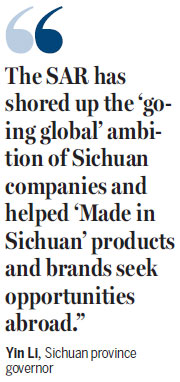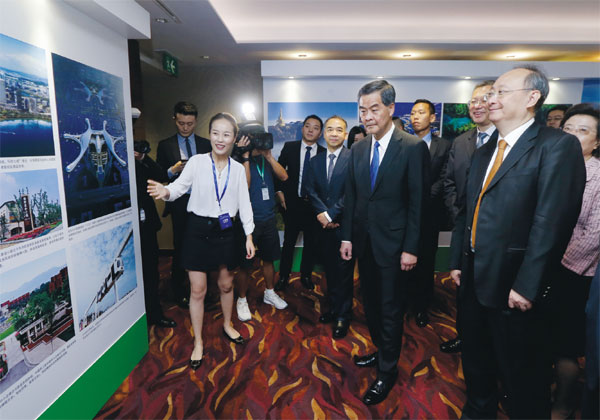Pandanomics - the HK link
Updated: 2017-08-23 07:58
By Luo Weiteng in Hong Kong(HK Edition)
|
|||||||||
|
Leung Chun-ying, vice-chairman of the National Committee of the Chinese People's Political Consultative Conference and former Hong Kong chief executive (second right), Yin Li, governor of Sichuan province (first right), and other officials visit a Sichuan-themed exhibition in Wan Chai on Tuesday held in conjunction with the "Sichuan-Hong Kong-Macao Cooperation Week". Roy Liu / China Daily |
Sichuan province seeks to beef up economic, trade ties with the SAR and tap Belt and Road potential to the fullest
As much as everyone loves the giant panda - China's national treasure - Sichuan province promises to offer even more than just the adoration for the iconic creature.
Situated in Southwest China, the "Land of Abundance", as Sichuan is known, is betting big on partnering Hong Kong to reap a bumper harvest from the undertakings and goals of the landmark Belt and Road Initiative.
Applauding the potentially huge opportunities from the nation's vision of reviving its ancient trade route, Hong Kong and Sichuan, both strategically located along the Belt and Road route, aim to push their collaboration to new heights, Sichuan Governor Yin Li told the Sichuan Promotion Conference on International Cooperation under the Belt and Road Initiative in Hong Kong on Tuesday.
The governor is leading a provincial delegation of his top aides, including Fan Ruiping, a member of the Standing Committee of Sichuan Provincial Party Committee, and Fan Bo, director of the Sichuan Provincial Development and Reform Commission, as well as heads of policy bureaus, on a week-long visit to the SAR.
The conference is part of the "Sichuan-Hong Kong-Macao Cooperation Week" signifying the province's determination to jump on the Belt and Road bandwagon and polish its label as the country's western financial hub.
Up to 26 bilateral investment and trade pacts worth more than $20 billion and covering a wide range of sectors, including finance, culture, tourism, agriculture, manufacturing and energy, have been sealed at the conference.
"With a long and fruitful track record of bilateral cooperation, Sichuan province and Hong Kong are highly economically complementary. Hong Kong, as a pivot city of the Belt and Road Initiative, is more than willing to share its expertise and join forces with Sichuan to explore the golden opportunities along the route," said Leung Chun-ying, vice-chairman of the National Committee of the Chinese People's Political Consultative Conference and former Hong Kong chief executive.

The SAR has long been Sichuan's largest source of foreign direct investment (FDI) and is the province's fourth-largest trading partner. By 2016, a total of 4,898 Hong Kong-based enterprises, including conglomerates Jardine Matheson Holdings and Hutchison Whampoa, had set up operations in the province, accounting for as much as $48.7 billion in FDI and generating revenues of $41.9 billion.
As one of the major taxpayers and employers in Sichuan - the country's sixth-largest provincial economy in terms of gross domestic product - Hong Kong enterprises had contributed tax revenues of $2 billion to local governments and provided more than 200,000 jobs as of last year.
Since the Closer Economic Partnership Arrangement was signed in 2003, bilateral trade between Sichuan and Hong Kong has surged, registering an annual growth rate of above 20 percent.
"The financial center in Asia has long played and will continue to play the role of a 'super-connector' and gateway between Sichuan and the rest of the world," said Yin. "The SAR has shored up the 'going global' ambition of Sichuan companies and helped 'Made in Sichuan' products and brands seek opportunities abroad."
Hailed as western China's aviation hub, Sichuan aims to sharpen its edge with the construction of a new mega aviation project - Chengdu Tianfu International Airport.
The new airport, due to be completed by 2019 and operate alongside the existing Chengdu Shuangliu International Airport - one of the world's 30 busiest airports - puts the provincial capital on track to become the third Chinese mainland city to have a second international airport, with the province's aviation potentials up for grabs, Yin said.
"We're looking to work closely with Hong Kong, which has what it takes to become a major transit point, to unlock our international flight routes along the Belt and Road."
The Sichuan Pilot Free Trade Zone was launched in April this year as being among the third batch of government-endorsed pilot free trade zones.
Yin said the province wants to learn from the good experience of Hong Kong, which has retained its crown as the world's freest economy for the 23th year in a row, according to the latest Index of Economic Freedom compiled annually by think tank the Heritage Foundation, to promote investment and free trade in a more progressive way.
"As Chengdu pitches itself as a national financial center in western China, we hope to cash in on Hong Kong's well-established professional services industry and sound capital base, attracting more Hong Kong enterprises to beef up their presence in Sichuan, and getting more Sichuan firms to go public in Hong Kong and play a part in overseas mergers and acquisitions through the SAR," Yin added.
Xie Feng, Hong Kong-based commissioner of the Ministry of Foreign Affairs, recalled that when Sichuan was hit by earthquakes in 2008 and 2013, Hong Kong extended its unwavering support for relief efforts, underscoring the valuable bilateral relationship between the two regions.
"Gaining momentum from the Belt and Road push, Sichuan is well ready to write a new chapter in the bilateral partnership with Hong Kong," he told the conference.
As next year marks the 10th anniversary of the 7.9-magnitude earthquake in Wenchuan, Yin invited Hong Kong people to visit Sichuan to see for themselves how the province has bounced back from the devastation.
sophia@chinadailyhk.com
(HK Edition 08/23/2017 page16)
